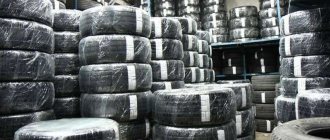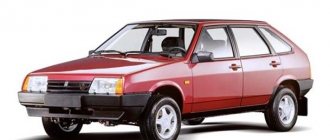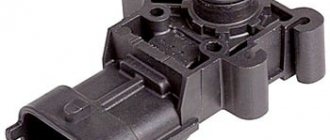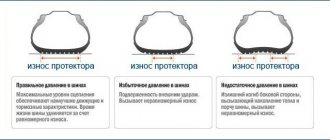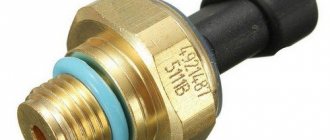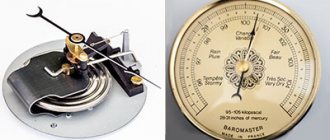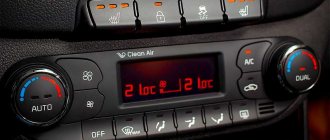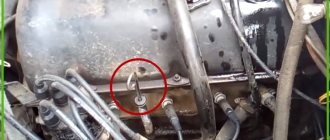Incorrect vehicle tire pressure can cause uneven tire wear and poor vehicle handling. In addition, low tire pressure increases the risk of wheel puncture, so-called hernias and damage to the wheel rim.
You can find out the recommended tire pressure values for your car in the “Car tire pressure” section.
If the tire pressure is too low, the car will handle worse, the car will “float” on the road, this is especially noticeable at high speeds. By the way, this is the first sign of a flat tire. Therefore, if you feel that the car has become difficult to handle and float on the road, choose a suitable place on the side of the road and check the tires. Look at the wheels to see if the tires are flat, and check the tightness of the mounting bolts (especially if you recently visited a tire shop).
If the tire pressure is too high, the car will also handle worse, due to the fact that not the entire tread area works in an overinflated tire, but only the central part. The car will be very rigid, driving comfort will deteriorate and the load on the car's suspension will increase.
The correct tire pressure is determined not by the tire itself, but by the recommendations of your vehicle manufacturer! It cannot be written on the tire itself, since the same tires are used on different car models with different weights and other characteristics.
The recommended pressure is written in the vehicle's operating instructions. Sometimes it is written on a sticker, which can be located on the driver's door pillar or on the gas tank flap. Please note that the recommended pressure in the front and rear wheels usually has different values and depends on the load level of the car and the installed tire size.
If you still haven’t found the values recommended by the manufacturer of your car, call any official dealer, they will definitely help you.
You can also use the car tire pressure table in PDF format:
Car tire pressure table (2010 catalog). Car tire pressure table (2011 catalogue).
(If you do not have a program for reading PDF files, you can download it for free from the official website of the Adobe Reader developer).
Sometimes people do not use exact recommendations and adhere to the rule - for a passenger car you need to pump 2.2 atmospheres, and for the rear wheels - 2.0, and when the car is fully loaded, increase the value to 2.4 atmospheres (for the rear wheels). However, this method will be completely unacceptable for some cars, since the spread of recommended values for different car models is very large. Therefore, this method can only be used as a temporary method, when, for example, on the road you were unable to find out the necessary data using the above methods.
Units
In Russia, it is customary to indicate the pressure for tires in Atmospheres (Kilograms per square centimeter - kg/cm2). On some American cars, the instructions indicate it in PSI - this is Pounds per Square Inch. They can be easily recalculated into a unit that is more understandable to us - Atmosphere (atm) or a unit almost equal to Atmosphere - Bar (bar). Since 1 Technical Atmosphere = 1 bar (bar = atm * 0.980655).
1 psi = 0.068 atm
1 atm = 14.706 psi
those. if, for example, you have a recommended pressure of 29 PSI, then you need to divide it by 14.706
atm = 29 / 14.706 = 1.972 ≈ 2 atm
Tire pressure can also be measured in Kilopascals (kPa)(kPa = 6.89476 psi).
1 atm = 101.325 kPa
As a rule, Kilopascals indicate not the recommended, but the maximum permissible pressure in the wheel MAX PRESSURE, indicated in the tire marking on its sidewall.
Do not confuse the maximum permissible tire pressure MAX Pressure (which is indicated by the manufacturer on the sidewall of the tire) with the pressure that the car manufacturer recommends for proper operation of the car!
Temperature
The main indication for changing tires is weather and temperature conditions. When daytime temperatures are below 5-7 degrees and when night frosts occur, it is recommended to drive on tires with a winter rubber compound, since summer tires lose their grip. To put it simply, they “dumb”. Russian motorists are very fond of studded tires, as in winter they behave much better on bare ice. The rubber compound of winter tires was designed to operate in temperatures mainly from -25 to +5.
Wheel pressure conversion table
For the convenience of converting from PSI to Atmospheres (atm), Bars (bar) and Kilopascals (kPa), we offer you a summary table with which you can easily convert the required pressure for the wheels of your car from one unit to another:
| Pressure in psi | 20 | 21 | 22 | 23 | 24 | 25 | 26 | 27 | 28 | 29 | 30 | 31 | 32 | 33 | 34 | 35 | 36 | 37 | 38 | 39 |
| in kPa | 138 | 145 | 152 | 159 | 165 | 172 | 179 | 186 | 193 | 200 | 207 | 214 | 221 | 228 | 234 | 241 | 248 | 255 | 262 | 269 |
| to atm (bar) | 1.4 | 1.4 | 1.5 | 1.6 | 1.6 | 1.7 | 1.8 | 1.8 | 1.9 | 2.0 | 2.0 | 2.1 | 2.1 | 2.2 | 2.3 | 2.4 | 2.4 | 2.5 | 2.6 | 2.7 |
| Pressure in psi | 40 | 41 | 42 | 43 | 44 | 45 | 46 | 47 | 48 | 49 | 50 | 51 | 52 | 53 | 54 | 55 | 56 | 57 | 58 | 59 |
| in kPa | 276 | 283 | 290 | 296 | 303 | 310 | 317 | 324 | 331 | 338 | 345 | 352 | 358 | 365 | 372 | 379 | 386 | 393 | 400 | 407 |
| to atm (bar) | 2.7 | 2.8 | 2.9 | 2.9 | 3.0 | 3.0 | 3.1 | 3.2 | 3.3 | 3.3 | 3.4 | 3.5 | 3.5 | 3.6 | 3.7 | 3.7 | 3.8 | 3.9 | 3.9 | 4.0 |
Tire pressure measurement
To measure air pressure in tires, there are various types of pressure gauges: dial gauges (operating principle is a manometric spring), mechanical (operating principle is a cylindrical spring) and modern electronic ones with a digital display.
Pointer pressure gauges are quite accurate, but they are “afraid” of falls and overload with high pressure, due to which the pressure gauge spring inside the pressure gauge deteriorates. Mechanical pressure gauges in the form of a “handle”, with a cylindrical spring, are much more reliable, but, as a rule, have less measurement accuracy. The most accurate at the moment are electronic pressure gauges, some of which can provide measurement accuracy up to ±0.05 Bar (Atmospheres).
The method of inflating tires “by eye,” to put it mildly, is not very good, since its accuracy (especially on uneven surfaces) is very low, and the pressure in different wheels inflated in this way can differ by almost two times.
Measurements must be carried out on “cold” tires, i.e. when the car did not move for several hours. It is best to do this in the morning, when the car has been parked all night.
the pressure in winter tires when the car was parked in a warm garage by 0.1 - 0.2 atmospheres, since when the car hits the street, the tires “cool down” and the pressure in them will be less. In the winter season, when the car is moving, the pressure in the wheels due to heating does not increase as much as in the summer.
We present to you a video, which we translated into Russian, from the Michelin company (which produces Michelin tires), it shows how to take measurements. To make it clearer, we converted the American pressure units - pounds per square inch - into atmospheres (Bars), which are more familiar to us.
Material prepared by Pokryshka.ru
Attention! All contents of this site are protected by intellectual property legislation (Rospatent, registration certificate No. 2006612529). Installing a hyperlink to site materials is not considered a violation of rights and does not require approval. Legal support of the site - legal..
Some “experts” and advisers like to say that in winter, in snowy weather, you need to lower your wheels a lot to make it easier for yourself to get out of snowdrifts or snow-covered ruts. Is it so? Not really…
The simplest, most correct and universal answer lies on the surface - the only correct pressure for a particular car is indicated in the operating manual for it, depending on the load of the car, season and modification. This information can also be duplicated on the gas filler flap, a sticker on the center pillar, etc.
What do the manufacturers say?
The automaker itself advises regularly, without specifying the exact time, to check the tire pressure. Our opinion is at least every 3-4 weeks. You need to be especially careful about this issue during the cold season. So, if your tires were inflated in a warm room, or at above-zero temperatures, and then it became noticeably colder at night, the pressure in the tires will drop slightly.
As for winter tires specifically, there are several nuances. If there is a desire and need to reduce the pressure of the car on the road surface, then, by analogy with participants in trophy raids, you can reduce the tire pressure by 2-3 tenths of an atmosphere, which in theory will increase the contact patch of the tire with the surface and, accordingly, reduce the pressure on the road and improve handling and grip on snow.
But the main nuance is that tire designers calculate them for the “normal” and only correct pressure. It is with it that the machine is provided with optimal operating conditions on snow, ice, cold dry asphalt, and snow slush. If you know that you will be driving for a long distance on loose, freshly fallen and unpacked snow, then it makes sense to slightly reduce the tire pressure. But if the snow-covered area is small, and you mostly drive on roads without pristine snow, then you should not reduce the pressure. This is fraught with a deterioration in the characteristics of tires (uneven and accelerated wear, deterioration of adhesion properties), and an increase in fuel consumption, and an increase in braking distance.
What is more important – the pressure or the tire itself?
There is also a myth among drivers that lowered tires will save you in winter if you use all-season or heavily worn winter tires. This opinion is erroneous, because the sipes on the tires are of particular importance because they bite into snow and ice, drain melted water and keep the car on course.
On flat, but bald tires, the car may not sink into the snow, but it will handle disgustingly and may skid in the most unexpected and seemingly harmless places.
Is nitrogen helpful?
Some dubious sites, with recommendations from selfish tire shop employees, sometimes recommend pumping a mixture of nitrogen and air into tires for the winter instead of the usual air that surrounds us, and that this has a better effect on handling during temperature changes, that the tires do not go flat, can withstand even microdamage, etc.
Is it possible to ride on spikes at 15 degrees Celsius?
The October temperature has dropped below 7 degrees, and the puddles are freezing in the mornings. But during the day the thermometer rises to 10 degrees and even higher. In sunny weather, the asphalt temperature can reach 15 degrees.
For winter spikes, such temperature changes pose serious challenges. What you need to prepare for in order to avoid possible problems when driving, and how not to “kill” spikes in warm weather, says marketing manager of Dunlop Tire CIS Natalya Dargis .
What should be the pressure in car tires in winter?
Studless winter tires should provide high-quality road grip and good handling on slippery roads and slushy snow. If the road surface is wet, running low tires increases the risk of hydroplaning . Those. complete or slight loss of traction, which is caused by the presence of a layer of water that separates the car tire from the road. Insufficient water drainage results in poor control accuracy.
There are 3 situations when the tire pressure of a car will not be optimal:
- Tires are overinflated;
- Tires are underinflated;
- The pressure on the 4 wheels is different.
A car with lower tire pressure in winter has more sway and poses a danger to all road users. Because The tire may fall off the rim while turning or while overtaking on the road. That is why you should check the tire pressure of a passenger car in winter at least 1-2 times a week, and always before a long trip.
Over-inflated tires in winter are more likely to be more dangerous than under-inflated ones . The contact patch with the road surface will decrease and will only be in the center; moreover, it will lose elasticity. And don’t forget about braking, the braking distance will be much longer.
A decrease or increase in tire pressure by 15-20% leads to premature wear of up to 30% percent. Therefore, it is so important to check the pressure in your car tires in winter and summer; such prevention will significantly reduce their service life. A significant difference in pressure in a car's tires in winter is felt on slippery surfaces, which can lead to an increased tendency to skid.
check the tire pressure of your car regularly. Over-inflated tires reduce the quality of braking. With underinflated brakes, the braking distance will decrease due to an increase in the contact patch, but vehicle control will deteriorate significantly and fuel consumption will increase. Moreover, such tires wear out faster.
The optimal tire pressure for a passenger car is indicated in the owner's manual or on the body. Please note that these figures are correct for a cold tire . Those. for one that was at rest for at least 2 hours after moving, or drove no more than 3 km.
On hot (warmed up) tires the pressure will be 0.3 bars higher than on cold ones.
Worth knowing! A hot tire with low pressure must be inflated. It is not recommended to deflate a tire with increased pressure.
Optimal car tire pressure in winter
Tire pressure is affected not only by heat, but also by air temperature. And this is worth taking into account. When the air temperature rises, the pressure will increase, and when it decreases, it will decrease. How will the air pressure in the tires change when the temperature changes relative to zero:
- At a temperature of +25 degrees, the pressure will increase by 0.8 atm;
- At a temperature of -25 degrees, the pressure will drop by 0.8 atm.
It is worth remembering that the level of wheel inflation may differ from the optimal level depending on the load of the machine.
What is the optimal tire pressure for a car in winter? The one recommended by the manufacturer. You can find it in the maintenance book, on the door pillar, glove compartment or gas filler flap. It may differ for different car brands and depends on the following factors :
- Vehicle weights;
- Diameter and size of wheel rims;
- From the tire itself, its index.
From this we can conclude that the pressure in the wheels of R16 will be different from R13. R13 wheels are mostly equipped on cars from the domestic auto industry. It is worth keeping in mind that the optimal pressure values will not differ for winter and summer.
It is precisely those indicators recommended by the automaker that can guarantee optimal stability, handling and fuel consumption.
In order to more or less broadly answer the question of what the pressure should be in a car’s tires in winter, we present a table . The table provides information on the VAZ .
Sealing mixtures and armor
In case of “catching a nail”, there are various mixtures. You just need to pump them into the wheel in advance, after which you can safely drive to the tire shop. Tires have long been invented that can continue moving, even if there is no air in them.
These are the so-called hard side tires. On such tires, if there is a puncture or valve failure, you can drive at speeds of up to 80 km/h. The car maintains maneuverability and stability in turns. These tires are called Run Flat.
Armored limousines are equipped with wheels equipped with special rims and inserts-bandages consisting of high-strength metal or plastic. Even if the car explodes or the tires are deformed, they can travel a very significant distance at a speed of 60-80 km/h. Of course, such wheels are an expensive pleasure.
How to measure car tire pressure in winter and summer
To measure the pressure in a car's tires, a special device called a pressure gauge . Whether it is mechanical or electronic does not matter, their function is the same. Modern cars are equipped with an automatic pressure control system, which displays readings on the dashboard, eliminating the need to use a hand-held device.
Do not also forget that the pressure gauge also has an error, it is indicated on the device. Therefore, it is necessary to take it into account when measuring.
It is necessary to check the tire pressure of a car with a pressure gauge in winter only on cold tires. Those. before heading out on the road.
You can buy a pressure gauge at any auto store. If this is not possible, then you can check the inflation level of your car’s wheels at any tire service station or gas station.
How often should you check tire pressure in winter?
It is necessary to check the pressure in the tires of a passenger car at least 1-2 times a week in . And you need to take this seriously, especially with sudden and constant temperature changes.
It is best to check pressure on cold tires . It is never a bad idea to check if there is a significant or sudden change in temperature.
- As the air temperature rises, the tire pressure will increase;
- If it decreases, it will decrease.
This is why it is so important to systematically monitor and adjust the pressure in your car tires to the optimal level in winter.
How safety decreases when changing tire parameters
The nature and measures to reduce road safety are well illustrated by the table, which reflects changes in the nature of the passive safety of a passenger car.
Tire pressure measurement
Table 1. Effect of tire pressure on safety and wear resistance:
| Changing the pumping indicator | Nature of influence |
| Normal | Vehicle safety and controllability Normal fuel consumption |
| — 0.5 bar | An increase in tread wear by 20%, the possible mileage is approximately reduced by 8 thousand km. |
| — 1 bar | Dangerous driving parameters, additional fuel consumption. |
| — 1.5 bar | The car may lose control of the road |
| — 2 bars | Braking distance on wet asphalt increases to 11 m. |
Note! A wheel that has been used in a poorly inflated condition may explode when the parameters are restored, and this can happen right on the road.
By the nature of wear, you can determine whether increased or decreased parameters usually occur on your model. This is well illustrated in the photo.
How to properly inflate tires in winter
A few tips on how to properly inflate your tires in winter :
- If you are going to inflate cold tires, it is better to do it outdoors. Because the temperature of the air inside the tire will be equal to the ambient temperature. You should rely on the manufacturer's recommendations. The optimal pressure in car tires in winter and summer is no different.
- If you pump up your tires in a warm garage, where the temperature inside is higher than outside. We recommend increasing the optimal values to 0.2 bar. In this way you will compensate for the temperature difference.
The driving performance of a car is affected not only by the degree of inflation of the wheels of a passenger car, but also by the tire itself. Choose quality winter tires .
A slight decrease in tire pressure is also allowed, i.e. to a level less than optimal. When is it necessary and what does it give:
- Relevant when you need to move on slippery road . Reducing tire pressure by 0.1-0.3 bar will increase the contact patch with the road, providing more stable traction.
- When driving off-road . The car will be more passable.
Features, regulatory values, risks
Most car owners perceive wheel pressure as a certain constant value that needs to be maintained from time to time. Moreover, if any person interested in the topic thinks about it, he will be able to list the main functions assigned to tires:
How much attention the driver pays to his tires can be judged by the tread, which wears out in a characteristic way. Based on wear, you can identify the main problems that are typical for a passenger car in motion. But treads are only a reflection of the problems that the car experiences if the requirements are not met. The main risks of insufficient attention to these aspects are related to safety. In fact, by ignorance or oversight, by letting this problem take its course, you expose yourself and your loved ones to a significant risk of an accident.

